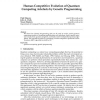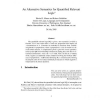44 search results - page 2 / 9 » ec 2006 |
IROS
2006
IEEE
14 years 1 months ago
2006
IEEE
— We created a human-robot communication system that can adapt to user preferences that can easily change through communication. Even if any learning algorithms are used, evaluat...
EC
2006
13 years 7 months ago
2006
We show how Genetic Programming (GP) can be used to evolve useful quantum computing artefacts of increasing sophistication and usefulness: firstly specific quantum circuits, then ...
BMCBI
2006
13 years 7 months ago
2006
Background: Despite the current availability of several hundreds of thousands of amino acid sequences, more than 36% of the enzyme activities (EC numbers) defined by the Nomenclat...
CORR
2006
Springer
13 years 7 months ago
2006
Springer
Functional brain imaging is a source of spatio-temporal data mining problems. A new framework hybridizing multi-objective and multimodal optimization is proposed to formalize these...
JSYML
2006
13 years 7 months ago
2006
The quantified relevant logic RQ is given a new semantics in which a formula xA is true when there is some true proposition that implies all x-instantiations of A. Formulae are mo...



